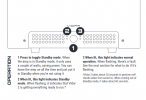My experience has been.... 1990's = ADCOM, 2000's = Parasound, 2010's = Schiit, 2020's = Nord (NC252)
I wonder how my Vidar 1 compares to the old ADCOM 545 II? I'm pretty sure power-wise, the others are all very close.
I still love the ADCOM when it's hooked up. Today, I found the Vidar to be pretty smooth and mellow on some older B&W I'm trying to get used to, usually a KEF guy. The thing is, the Vidar shuts down pretty friggin easy. I would rock the ADCOM at parties with the yellow distortion lights steady...and it would still be cranking with dynamics. The best part is it NEVER shut down. I dunno how I would deal with it in a live situation, but for sure the Vidar shuts TF down.
But, nfw I would pay $800 for the Vidar 2. My Vidar 1 was much less expensive. I did some inflation calculation on the old school 2 channel receivers we love. Every one I look at ended up being $1500 in 2024 dollars. The funny thing is, when I took the cheap new $200 2024 Yamaha that has a nice 100w AB and ran the numbers in reverse, that receiver would be $55 in 1980. So by the metric of how MUCH MUCH better cost/performance we get now a days, it really makes that Vidar 2 look like a terrible deal.
I have a big room for testing swapping and matching systems now. It's a thing that was totally lacking for me in the past. I have all my old amps and speakers cycling now. All I know is the Parasound is going onto PA speakers. It has the most power and the worst sound, lol.

